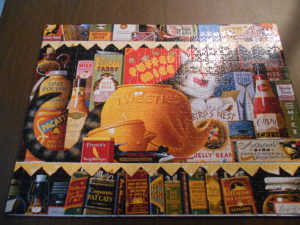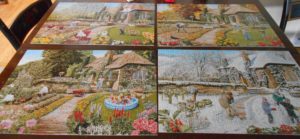Puzzling
A lot of my friends tell me they are coloring. It’s a thing, isn’t it, Adult Coloring. Some are binge-watching anything with a good story and lots of episodes. Almost everyone is taking an anti-depressant. I suspect there’s a fair amount of self-medicating with sugar. It’s a surreal time.
Me, I’m doing jigsaw puzzles (and binge-watching anything with a good story, taking doctor-prescribed anti-depressants and self-prescribed sugar in various forms.) I find them (the puzzles) meditative and calming. It’s comforting to go through a process that ends with everything fitting into place and creating something predictable.
The Experts, as I understand it, don’t reference the picture on the box as they work. They use the colors, values, lines and shapes to help them assemble the picture. I’m not an expert. I’m just an anxious American trying to keep my equilibrium.
So I dump the thousand puzzle pieces onto the table—an old leather-topped folding table my parents used for Bridge. I am not afraid of chaos. It’s not my favorite thing in the world but I understand its usefulness and I enjoy creating order out of it. So I start looking for the puzzle pieces with hard edges. I always tell myself that this time I will find every single hard edge on the first sifting. I will look at every piece and my mind won’t wander. This never happens. But eventually I get the frame.
The frame. There’s a phrase I like in a poem, “The Reverse Side,” by Stephen Dunn: “the lie of the frame:”
It’s why the terrified and the simple
latch onto one story,
just one version of the great mystery.
Image & after-image, oh even
the open-minded yearn for a fiction
to reign things in –
the snapshot, the lie of the frame.
In times of chaos and panic, we click the shutter. We get a snapshot that contains as much as we ourselves can contain. The larger context is obliterated. There’s nothing wrong with this. I just think it’s good to know that’s what we’re doing.
A calming technique I like is to look in front of me but focus my attention on my peripheral. I see myself in a context. Oh, I am not just an isolated sheet of white panic flapping on a line, I am a being with a place in the world and here I am, supported by the universe. My frame has widened and it has stabilized me and given me more breathing room.
Once, alone in a hotel in New York City, I felt emotionally invaded by the noisy phone conversations of the guy in the next room. At the time this was the kind of thing that would typically have triggered a panic attack. I felt the beginnings of one simmering. It didn’t help that I was out of my familiar world—in a different puzzle, so to speak. Something deep within me just up and moved the frame: I said to myself, “This doesn’t have to mean what it has always meant. This can mean something different.” It worked. I started taking deep breaths. The sounds on the other side of the wall were demoted from panic trigger to mildly annoying.
After the frame come all the easy bits: the patches of bright colors, the discrete objects, and salvaging all the freebies: the pieces that came out of the box already attached. Then the endless sifting through, starting to appreciate the many shades of blue, for example. This sky is darker over here. This is the light blue on the horizon over by the barn. And this orange can’t be the farmer’s shirt because his shirt is clearly red. But the orange piece fits right under the farmer’s head and next to the dark blue of the farmer’s trousers it looks much less orange and much more red. By this time I am thinking, “Hmm, cadmium red medium maybe and Indanthrone blue.”
I am down to all the little weird pieces in the easy bits phase. Things that are obviously not part of the sky or the grass or (god help me) the wheat field. I can’t figure out what the heck they are or where they go. They pass through my hands over and over and I look from them to the puzzle to the picture on the box. The conscious part of my mind relaxes and a deeper mind takes over. Suddenly my hands are moving without me analyzing what they are doing. They put the all the weird little pieces into their place. This is actually an example of the creative process, which doesn’t differentiate between the grand and the humble.
The last part of the puzzle involves the grunt work of filling in the wide open spaces of a single color or the insistent gravel of no pattern. I start looking at puzzle shapes: the broad shouldered men ones, the broad shouldered men trying to run away. If I turn them around they look like broad–shouldered men giving birth to a baby and trying to run away—now there’s a frame. The four-pointed ones and the hunchback, club-footed ones. It’s a process of laboriously trying every piece on every side in every way. At some point my deeper mind again takes over and finishes the puzzle.
When I have planned to ruin my day by working on my taxes, a puzzle is so much more satisfying. It calls to me more insistently than even the refrigerator. I can’t walk past it without sitting down and becoming engrossed. My shoulders and neck get unhappy, I’m up past my bedtime, the sink is perpetually full of dishes, the cats are perpetually whining but for hours and hours I don’t worry about my health care, the cruelty of the immigration deforms—yes, you read that correctly— the stupidity of the department of education or the treatment of women all over the world. There’s always tomorrow and I am temporarily out of puzzles.
 RSS Feed
RSS Feed

This is exquisitely written and so expresses my feelings and angst about what is happening in this country. Many thanks for putting my vague dis-ease into words.
One time my family and I were at a hotel in Monterrey. About 4 in the morning a man with a loud voice was talking on the phone for a long time. My family slept through it, but not I. It drove me nuts!